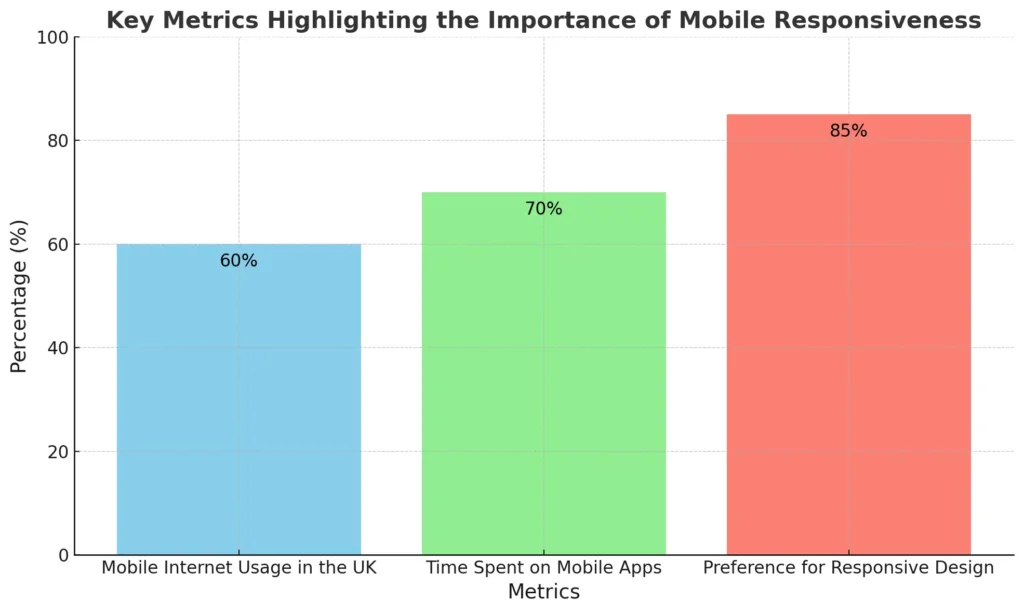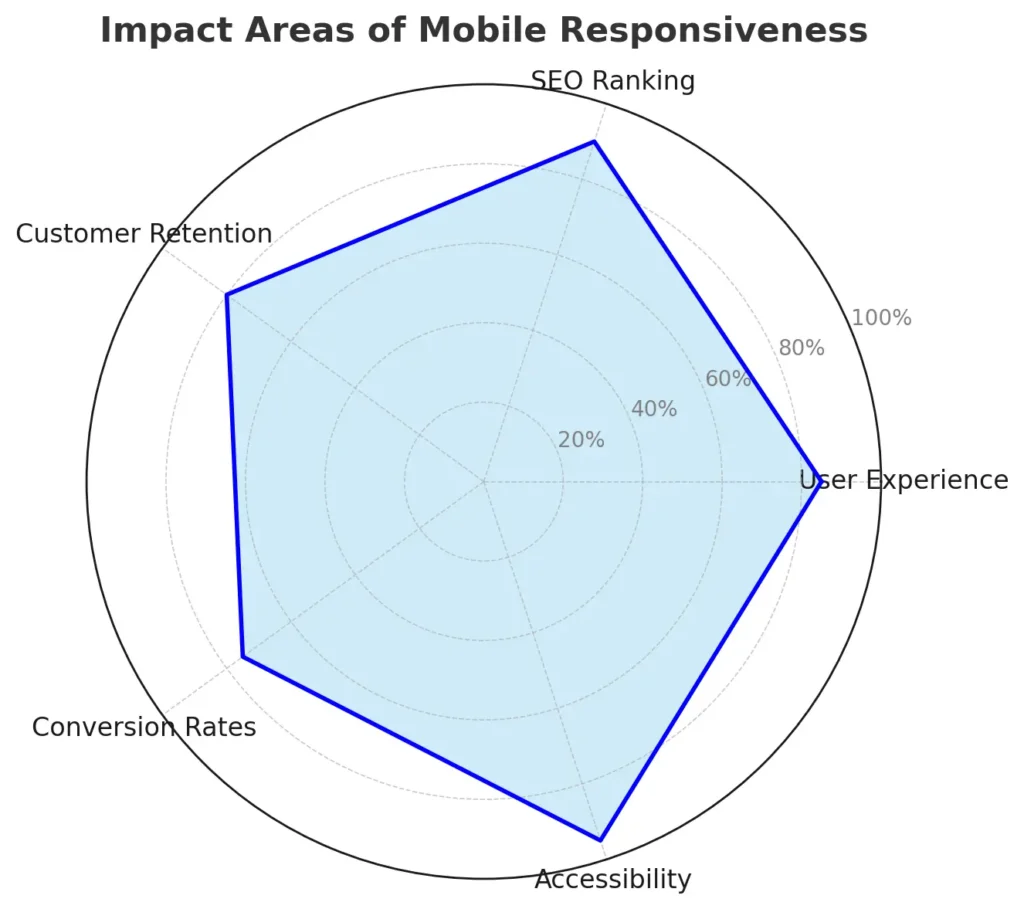Almost 60% of all web traffic these days comes from mobile devices. This shows how important mobile speed is today.
Your online success depends critically on your site’s performance on mobile devices as more and more people access it from their phones.
In this post, we’ll look into mobile response. We will discuss their importance and the general rules of good, responsive web design.
Whether you operate a company, market goods, or build websites, understanding mobile responsiveness will enable you to produce sites that appeal to your target market and yield results.
Describes mobile responsiveness
Mobile devices are everywhere in modern society. Mobile responsiveness is absolutely important. The website thus performs effectively on all screens and devices. Users, therefore, have a wonderful experience.
Definition and Relevance
Mobile responsiveness makes navigating webpages simple on phones, tablets, and more. Use fluid styles to adapt to any width: desktop, tablet, mobile. Your material will thus look great on any device.
Important Elements of Responsive Design
- Websites employ fluid grids with changing scales depending on the screen. This keeps the looks of the mechanism appealing and consistent.
- Viewport Meta Tag: This tag in your website code instructs the browser on the mobile phone page. It gives the page a suitable appearance on small screens.
- Media Queries are CSS’s means of varying styles depending on the device. These include screen size, orientation, and pixel density.
- Websites change their content to suit several devices. This guarantees simple use and reading of everything.
Knowing responsive design enables one to create better websites for mobile readers. It increases your brand’s internet presence and generates content for the satisfaction of consumers.
Any current, mobile-friendly website must have a responsive design; it is no longer a choice.
High Mobile Phone Use
Mobile internet access has surged sharply in recent years. This results from the growing number of people utilizing tablets and cell phones. Businesses that wish to get online now depend on knowledge of how consumers use mobile devices.
Statistics on Mobile Internet Access
In several countries, reports reveal that mobile internet use has exceeded desktop use. For instance, almost 60% of web traffic in the UK originates from mobile phones. This emphasizes the need for mobile-optimized websites.
User Behavior of Mobile Phones:
- More people than ever are depending on smartphone apps. Their preferred apps are those with simple interfaces.
- Everybody expects websites to function on every kind of gadget. Websites, thus, have to be mobile-friendly.
- Content that is simple and fast to grasp is what mobile users want. They enjoy movies and little stories.
These developments draw attention to the requirements of mobile user behaviour in today’s digital era and device compatibility. Companies that prioritize mobile-friendly design and content will succeed in the mobile age.

Why Is Mobile Responsiveness Important?
These days, your site’s appearance on mobile devices is vital. It influences consumer retention, search engine results, and user sentiment. The success of online companies depends on a flawless mobile experience now.
Impact on User Experience
Finding and using your content is simpler when a site performs effectively on all devices. Because they can rapidly locate what they need, this makes consumers pleased. Contented customers are more likely to return and make purchases from you, enabling your company’s expansion.
As has been seen, it may affect how search engines rank the web pages.
Google loves webpages that fit mobile devices. A responsive site tells Google your site is excellent for users. Should your website lack mobile friendliness, Google might not show it as frequently, increasing the difficulty of finding you.
Function in Retaining Customer Attention
- A good mobile experience makes consumers content and brand loyalists.
- Optimized loading time and easy site journey allow customers to interact more, thus making them buy more products and return to the site more often.
- Users of phones who can quickly access your goods and services are more likely to remain brand loyal.
A responsive website is not only great but also necessary in today’s mobile environment. Emphasizing mobile devices will help maximize your website, raise your search engine results, and keep more visitors. Your brand will experience long-term success.

Foundation of Responsive Design
From huge desks to small phones, a responsive design makes the websites usable on multiple devices. It guarantees customers a fantastic experience, independent of screen size, by leveraging a few fundamental concepts.
Flexible Grids and Adaptable Plans
Flexibility in layouts and grids in use is the key concept of responsive design. The grid system changes its scale according to the screen. This maintains that the material appears accurate even with screen changes.
This adaptability lets websites seem different to suit the user’s device.
Media Notes and Breakpoints
The fluid grid system is supplemented by media queries and breakpoints. Media inquiries look at device specifics, including screen size. It then makes the best use of CSS to arrange this gadget.
Markers indicating the layout’s change for various devices are breakpoints. This guarantees that the site looks well on every screen.
| Responsive Design Principle | Description |
| Fluid Grids | A grid-based arrangement can change its dimensions depending on the screen area. |
| Flexible Layouts | Media Queries CSS rules are used to identify the client’s device features like screen size, resolution, and orientation for the improvement of the layout. |
| Media Queries | Media Queries CSS rules are used to identify the client’s device features like screen size, resolution, and orientation for the improvement of layout. |
| Breakpoints | Operation points where the design shifts to fit various classes of devices are known as breakpoints. |
Online designers can produce responsive web designs using fluid grids, layouts, media queries, and breakpoints. This makes websites very good on several gadgets, thus making their use easier.
Designed for several devices
It’s crucial to ensure your website runs on several devices. These days, cross-device interoperability is both a good and a need. Before that, you must know about screen sizes and evaluate them to make them suitable for everyone.
Mobile Response: Knowing Screen Dimensions
With the several screen widths available, web designers have a great difficulty. From phones and tablets to laptops and desktop computers, every device shows its website in a unique manner. Responsive design—using fluid layouts and grids—helps your site fit any screen size. This makes design and content excellent across all devices, enhancing user experience.
Testing on Various Platforms
A responsive website depends quite a lot on device detection. You need a cross-browser, OS, and device check of your site to identify any issues. Other diagnostic techniques include emulation techniques, such as emulators and virtual machines, and buying actual hardware to test on to check for faults. This guarantees that your website runs on every kind of gadget.
| Type of device | range of screen sizes | Suggested Examine |
| Smartphones | 4.7 – 6.5 inches | iPhone, Android, Windows Phone |
| Tablets | 7.9 – 12.9 inches | iPad, Android, Windows Tablet |
| Laptops | 13 – 17 inches | Windows, macOS, Chrome OS |
| Desktops | 17 – 32 inches | Windows, macOS, Linux |
Knowing all screen sizes is crucial; hence, test your website on several devices. This assists you in making sure that whether someone is using a laptop, tablet, or iPhone, everyone is happy.
Advantages of Mobile Responsiveness
One gains a lot by having a mobile-friendly website. It might improve your website’s view and assist you in achieving better outcomes. Let’s look at improving sales, attracting more visitors, and making your site more easily navigable.
Mobile Reactivity: Enhanced User Accessibility
A website that performs effectively on mobile devices offers users an outstanding experience. It also enhances its use in different screen sizes, making it usable. This makes the consumers happy and is a force that calls them back for more.
Boosts Website Visitors
People are connecting to the Internet using their phones in increasing numbers. Attracting and keeping visitors depends mostly on making a site compatible with mobile devices. Furthermore, search engines such as Google favour mobile-optimized websites. Additional people will thus be able to locate your website, facilitating your attraction of extra guests.
Boost conversion rates
A decent mobile-responsive website serves purposes beyond just visitor attraction. It enables users of phones to act—buying something or subscribing. A stronger internet presence and greater sales follow from this.
Stressing mobile-friendliness will help your website create fresh chances. This enables you to meet the new needs of your audience and contributes to the process of brand growth.

Case Studies: Successful Mobile Responsiveness
Mobile responsiveness is revolutionary in the hectic field of digital marketing. Businesses interact with their consumers in this way nowadays. Let us review some case studies illustrating the value of mobile responsiveness. We will also get wiser from the errors.
Names of Companies That Have Made Successful Transitions
One excellent example is Starbucks. Their website and app now appeal to mobile devices. This has raised sales and consumer involvement. Another success tale is Airbnb. More mobile bookings result from their simple navigation and booking process, which is made possible by their mobile-friendly design.
Learnings from a Poor Implementation
Some companies have discovered painful lessons in mobile responsiveness. One of the top fashion stores turned aside mobile optimization. Poor user experience, less traffic, and lost sales came, of course, from this. The key lesson discovered is that neglecting case studies on mobile responsiveness might damage your company.
These illustrations show the need for mobile responsiveness in the modern world. Concerning the perfect user experience, no matter what device is used, it assists businesses in growing, gaining customers’ trust, and succeeding.
Frequently Asked Questions
Most individuals visit websites on cell phones. On every device, responsive design makes using your site simple. This enhances user experience and could raise the search engine results for your website.
Responsive web design takes advantage of flexible layouts and fluid grids. Media queries change the site’s look depending on the gadget. This guarantees flawless operation on any gadget. A well-designed personal website template can showcase your expertise in any design.
For example, in chip design, highlight your portfolio, and communicate your professional brand effectively.
User experience and SEO are much influenced by mobile responsiveness. Responsive sites load fast and are simple to use. The key to SEO ranking is user engagement, which raises it.
Steer clear of neglecting touchscreen usability and failing image optimization. Furthermore, avoid using fixed-width layouts and test your site on several devices. Emphasize a flawless mobile experience to guarantee your site is responsive.
There are a few tools or resources through which one can get help in responsive design. Elements are available through using frameworks like Foundation and Bootstrap. Browser Stack and other testing tools assist in examining and enhancing the mobile responsiveness of your site.





